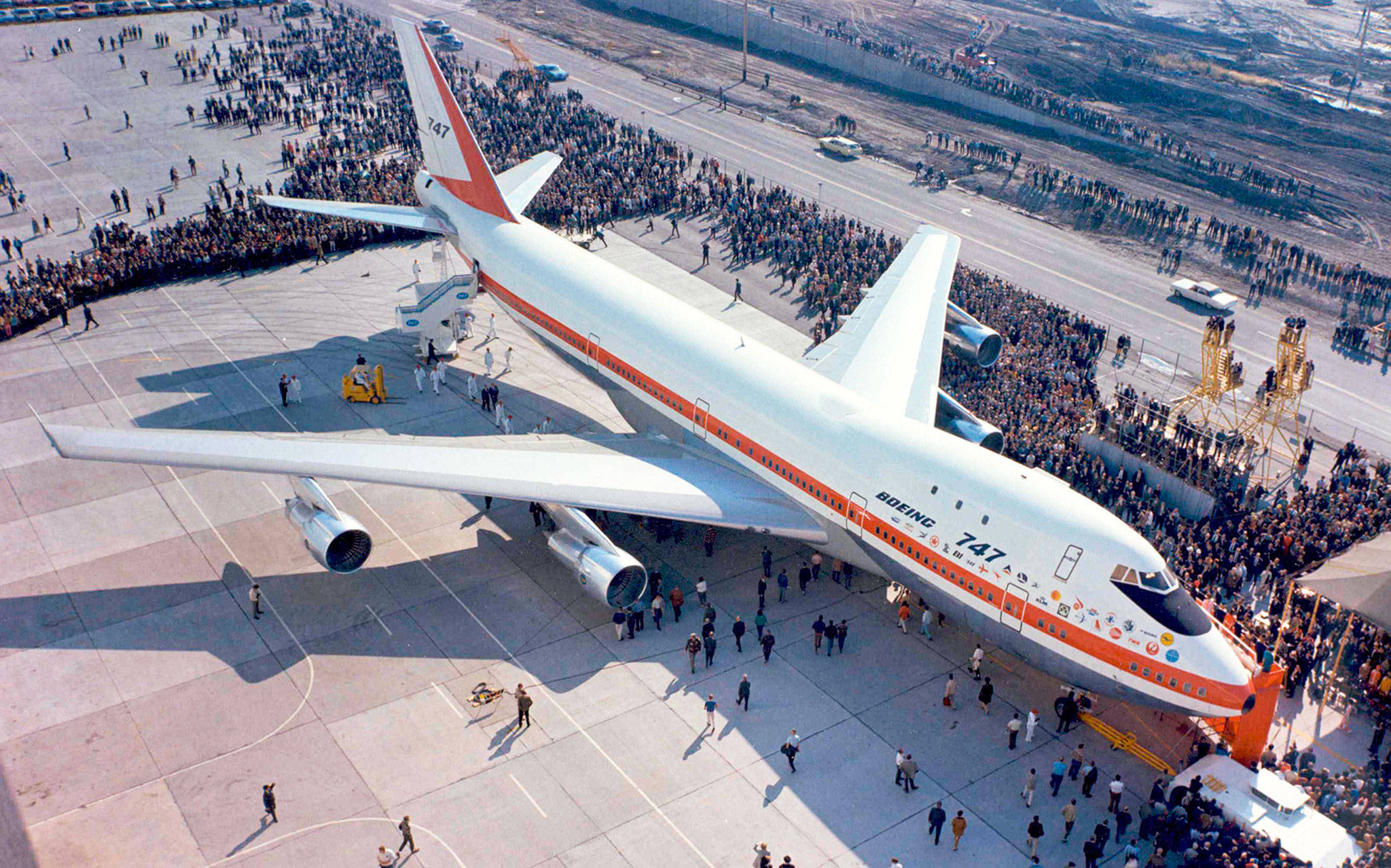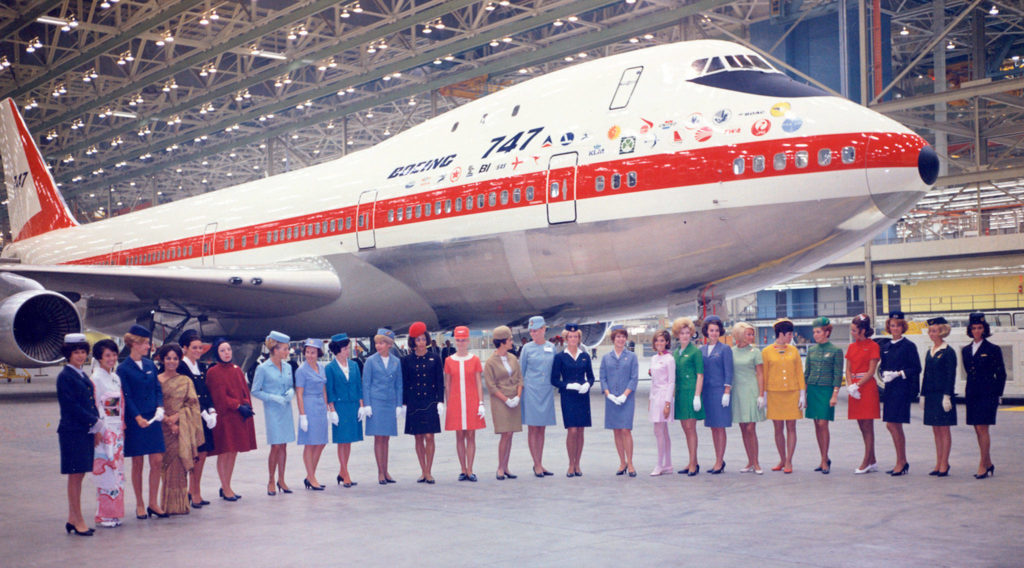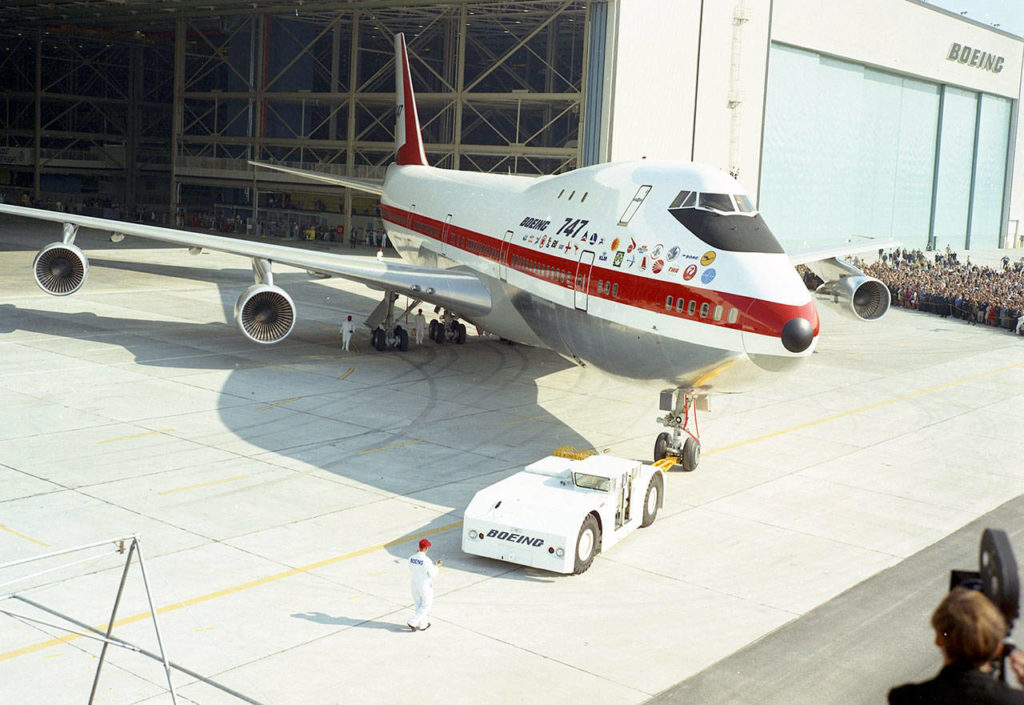EVERETT — It was a little bit like a circus. Security at Boeing in those days wasn’t anything like today. Curious onlookers drifted into the crowd of Boeing workers, executives and airline representatives.
“There must have been a thousand or more people there,” recalled Kelvin “Andy” Anderson, a retired Boeing supervisor.
“There were dignitaries from Everett and Snohomish County and the airlines. There were lots of speeches,” said Anderson, 79.
The star of the show was a shiny new jetliner with the Federal Aviation Administration tail number N7470, the first Boeing 747 airplane. Insiders called it by its Boeing serial number, RA001.
The occasion was its world debut, wrote Joe Sutter, who led the team of 4,500 engineers that created the worlds’ first twin-aisle commercial aircraft.
Fifty years ago, on Sept. 30, 1968, the first Boeing 747 emerged from the Everett assembly plant, which had recently been specially built at Paine Field to house the world’s first jumbo jet.
At 231 feet, the 747’s fuselage stretched two-thirds the length of a football field. Its wingspan measured 196 feet. The tail soared to the height of a six-story building.
The “queen of the skies,” as the Boeing 747 came to be called, rolled out of the hangar on a cold, overcast day, Sutter said his 2006 book, “747: Creating the World’s First Jumbo Jet and Other Adventures From a Life in Aviation.”
At the time, it was “two-and-a-half times bigger than any plane in service,” wrote Sutter. It was designed for double-duty — as a passenger plane able to carry more than 400 people and a freighter.
That led to the distinctive bulge on the fuselage, which gave it the look of a Beluga whale.
“An aircraft tug pulled it out of the hangar … Just as that impossibly high nose emerged into the open, the sun finally broke through … The crowd gasped audibly and broke into spontaneous applause,” Sutter said.
Sutter, Anderson recalled, was totally focused, “a manager’s manager.”
Anderson, who had joined Boeing in 1963 as an aircraft mechanic, was a supervisor at the Renton factory in 1967 when he was assigned to the 747 project, which the company had formally launched in March 1966.
“When I started working there they were still building the building while we were building the airplane,” said the Camano Island resident.
“To work on something that long and that many hours and then to see it roll out was quite an event,” Anderson said.
The 747’s big nose was adorned that day with the emblems of the 26 airlines that had committed to purchasing the first of the fleet. Among the logos: Pan Am, the airline that spurred Boeing to developing the first widebody jet, and United, Northwest, Delta and American.
“Flight attendants from those 26 operators lined up for photos in front of RA001,” Sutter said.
It would be another four-plus months, however, before the 747’s Pratt & Whitney engines fired up for the first test flight on February 9, 1969.
Anderson, remembers the test flight vividly. He held his breath, just a little.
“That was a heck of a jump to put that thing in the air,” he said. When it took off it looked as if it was not moving as fast as it was — 150 miles per hour.”
Boeing would make good on its promise to deliver the first 747 for commercial passenger service by the end of 1969, meeting Pan Am’s 28-month deadline. Today, the aerospace company might spend several years designing and building a new aircraft model.
For Anderson and a lot of other workers, the “impossible” timeline meant tons of overtime, he said. “I remember 10 and 12 hour days, seven days a week.”
On Monday, Anderson plans to visit the Everett assembly plant, where workers are holding a celebration to commemorate the half-century anniversary. Anderson’s son, Vic Anderson, 52, will drive him.
Vic, an aircraft mechanic, has worked on the 747 program since joining Boeing in 1988, fine-tuning the big bird’s hydraulics and main landing gear.
At 10 years old, he saw his first 747 up close, when his father brought him to work. He left, he said, with the hope of working at Boeing.
Today’s 747-8 is not your father’s 747.
For one thing, it’s larger. At 250 feet, the 747-8 fuselage is nearly 20 feet longer than that of RA001. The wingspan has grown, too, from 196 feet to nearly 255 feet. The flight deck technology and other systems are far more advanced, Vic Anderson said.
On the other hand, production has slowed. Anderson estimates that Boeing produced one 747 a week in 1988. Now it’s about one every two months. In recent years, new 747s are primarily freighters.
Kelvin Anderson worked in Everett on 747s from 1967 to 1982, then began a stint repairing them on-site for airline operators across the globe. He retired 10 years ago. Vic Anderson was assigned to the 747 program in 1988. Thirty years later, he’s still aboard.
Vic was 2 years old when the first 747 rolled out; Kelvin was 29. Since then, Boeing has produced more than 1,500 747s.
Between him and his dad, Vic Anderson figures, they’ve each had a hand in nearly every one of those mighty planes.
“It doesn’t feel like 50 years,” said Kelvin Anderson. “That day doesn’t seem that long ago.”
Today the original bird, which was named “City of Everett” in honor of its birthplace, is on display at the Museum of Flight at Boeing Field in Seattle.
Janice Podsada; jpodsada@heraldnet.com; 425-39-3097; Twitter: JanicePods
Talk to us
> Give us your news tips.
> Send us a letter to the editor.
> More Herald contact information.




























